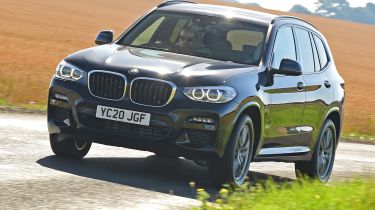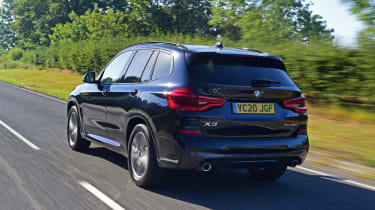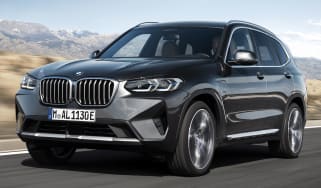BMW X3 hybrid review
The BMW X3 xDrive30e continues BMW's trend of offering impressive plug-in hybrid versions of some of its most popular models

Pros
- Performance vs efficiency
- Quiet and relaxing
- Great interior
Cons
- Heavy and feels it
- Compromises on practicality
- Petrol engine not the most refined
| Car type | Electric range | Fuel economy | CO2 emissions |
|---|---|---|---|
| Plug-in hybrid | 29-30 miles | 134-141mpg | 45-54g/km |
The BMW X3 xDrive30e is the plug-in hybrid version of BMW's compact luxury SUV. Unlike the brand's fully electric SUV, the iX3, the X3 xDrive30e bridges the gap between conventional petrol versions and electric models in a similar vein to its rivals, the Audi Q5 TFSI e, Jaguar F-Pace P400e, Lexus NX 450h+, Mercedes GLC 300 e and Volvo XC60 Recharge.
The X3 plug-in hybrid has an impressive power figure of 288bhp, thanks to the combination of its 181bhp 2.0-litre petrol engine and 108bhp electric motor. Unlike other models in the X3 line-up, the xDrive30e plug-in hybrid comes as standard with four-wheel drive and an eight-speed automatic gearbox.
The plug-in powertrain offers many advantages over conventional petrol and diesel options. Firstly, the hybrid X3 can return fuel economy of around 135mpg, producing just 46g/km of CO2 and thus making it a fine company-car choice with a low Benefit-in-Kind tax rate of just 12% (at least until April 2025). It's also capable of around 30 miles of pure-electric driving.
Yet newer rivals such as the NX 450h+ and updated XC60 Recharge go farther on a charge and have even better BIK and fuel economy figures. The X3 xDrive30e can still make sense for private buyers torn between this and the diesel-powered X3 xDrive30d because the plug-in hybrid has better resale values. But you'll still need to charge it regularly and avoid using the petrol engine for short trips if you want to lower your running costs significantly.
The claimed 30-odd miles is possible exclusively under electric power with a full battery – which means you won't use a drop of fuel on most shorter trips if you stick to good charging habits. Naturally, the electric motor can assist the petrol engine on longer trips; however, once the battery runs out, fuel economy drops significantly – as is the case with most plug-in hybrids.
The good news is that the X3 lives up to BMW's reputation for building great-to-drive cars; performance is strong and there's lots of traction if you drive enthusiastically. It's not exactly sporty, but it feels planted and safe.
Inside, the well-appointed cabin is among the best in this class, solidly built, sensibly laid out and spacious. The addition of batteries means there's less space available in the boot. However, the 450-litre capacity is on par with its plug-in hybrid SUV rivals’ boots.
All told the plug-in hybrid X3 is a tempting alternative to its oil-burning sibling. Read on to find out more about the X3 xDrive30e in the rest of our in-depth review…







